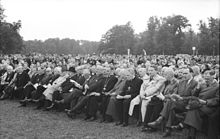German Evangelical Church Congress 1954
The 6th German Evangelical Church Congress in 1954 took place from July 7th to 11th, 1954 in Leipzig and had the motto Happy in Hope ( Rom 12,12 LUT ). With 650,000 visitors, the Annual General Meeting is the largest at a German Evangelical Church Congress . 60,000 permanent participants were registered. It was the last all-German Kirchentag until German reunification in 1990.
History, course and effect
The implementation of the 179 events of the Kirchentag had only been approved by the GDR leadership three months beforehand. The Saxon regional church had invited on the initiative of the deacon Herbert Dost, who sat in custody for four months as head of the Leipzig play community and was released on June 17, 1953 . Dost recognized the historical possibility of holding a mass church event after the persecution of Christians in the GDR. By the time the Kirchentag took place, the SED Politburo and the Ministry for State Security had already developed the strategy of repression against the Protestant churches, which had been practiced for over 30 years and which effectively excluded independent mass church events. The main focus of the large all-German Kirchentag was dealing with the history of National Socialism and its consequences. It is considered the impetus for the EKD's Ostdenkschrift and thus also for the later Eastern Treaties of the German federal government.
One of the most important speeches of the Kirchentag was given by Klaus von Bismarck on the subject of the Christian's freedom to hold and give . While one of his brothers was still in Soviet captivity, Bismarck appeared before the German public and said: “At this moment my heart is looking for the meadows, the fields and the trees in my home in Pomerania, which is now administered in Polish [...] It is my personal one Opinion - which some of you may not be able to adopt - that we have no right before God to get what He has taken from us. “This speech sparked heated controversy.
The general assembly of the Kirchentag took place on July 11, 1954 on the Rosentalwiese . The rain that led to a flood in Saxony was interrupted. 650,000 people gathered in the Rosental and demonstrated Christian freedom, an event that left a deep impression on the participants. The closing service was also on July 11th, it was celebrated in what was then the Leipzig Central Stadium , which held 100,000 visitors. The service was rung in by two bells hung on a steel frame. This scaffolding was later to serve as a bell tower for a parish in Eisenhüttenstadt .
See also
literature
- Hildegard Wulf (Ed.): Be happy in hope. The 6th German Evangelical Church Congress from 7. – 11. July 1954 in Leipzig. Kreuz-Verlag, Stuttgart 1954
- Be happy in hope! German Evangelical Church Congress in Leipzig from 7-11. July 1954. Main program. German Evangelical Church Congress, Leipzig 1954
- Heinrich Giesen (Ed.): Happy in hope. The Leipzig Kirchentag 1954. All German edition. Kreuz-Verlag, Stuttgart 1954
- Be happy in hope. A book d. Reminder from the Leipzig Kirchentag. Evangelical Publishing House, Berlin 1956
- Dirk Palm: We're brothers! The Protestant Church Congress and the German Question 1949-1961. Vandenhoeck & Ruprecht, Göttingen 2001
Web links
- On the history of the Kirchentage ( Memento from May 23, 2005 in the Internet Archive ) (PDF; 100 kB)
Individual evidence
- ^ Church days in Leipzig. "Be Merry in Hope" (1954), "Be patient in tribulation" (1978), "Hold on in prayer" (1989). Exhibition on DEKT 1997. Conception by Christian Dietrich, today part of the museum memorial in the "Runden Ecke" .
- ↑ Erhard Eppler : An exciting, dynamic piece of civil society. Speech at the reception of the city of Fulda on the occasion of the 55th anniversary of the German Evangelical Church Congress on September 24, 2004.
- ^ Christian Dietrich : The Rose Valley. Place of the largest mass event of German Protestantism. In: Waldstraßenviertel Heft 10 (1997), pp. 25-27.


